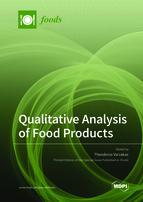Qualitative Analysis of Food Products
A special issue of Foods (ISSN 2304-8158). This special issue belongs to the section "Food Analytical Methods".
Deadline for manuscript submissions: closed (30 November 2017) | Viewed by 62152
Special Issue Editor
Interests: food technology; food engineering; food safety; food quality; extra virgin olive oil; mycotoxins; fermented foods
Special Issues, Collections and Topics in MDPI journals
Special Issue Information
Dear Colleagues,
Qualitative control and analysis of food products is a requirement for food industries, both in terms of quality assurance, and also in food safety management systems. Analysis of foods is continuously requesting the development of more robust, efficient, sensitive, and cost-effective analytical methodologies to guarantee the safety, quality, and traceability of foods in compliance with legislation and consumers’ demands.
Different analyses include microbiological and chemical analyses, from simple to complex, from old to modern technologies. Hence, fundamental and/or state-of-the-art methods of the development, optimization, and practical implementation in routine laboratories, and validation of these methods for the monitoring of food safety and quality are employed. Methodologies for food microbial contaminants, food chemistry and toxicology, food quality, food authenticity, and food traceability are important to be presented and discussed. Present and future challenges in food analysis, the application of “omics” in food analysis (including epigenomics, genomics, transcriptomics, proteomics, and metabolomics), and a general overview on the new discipline of Foodomics can be discussed.
Statistical analyses are also a tool for the qualitative analysis of food products, which, in conjunction with other tools, such as chemometrics, can aid in the direction of food safety.
Prof. Dr. Theo H Varzakas
Guest Editor
Manuscript Submission Information
Manuscripts should be submitted online at www.mdpi.com by registering and logging in to this website. Once you are registered, click here to go to the submission form. Manuscripts can be submitted until the deadline. All submissions that pass pre-check are peer-reviewed. Accepted papers will be published continuously in the journal (as soon as accepted) and will be listed together on the special issue website. Research articles, review articles as well as short communications are invited. For planned papers, a title and short abstract (about 100 words) can be sent to the Editorial Office for announcement on this website.
Submitted manuscripts should not have been published previously, nor be under consideration for publication elsewhere (except conference proceedings papers). All manuscripts are thoroughly refereed through a single-blind peer-review process. A guide for authors and other relevant information for submission of manuscripts is available on the Instructions for Authors page. Foods is an international peer-reviewed open access semimonthly journal published by MDPI.
Please visit the Instructions for Authors page before submitting a manuscript. The Article Processing Charge (APC) for publication in this open access journal is 2900 CHF (Swiss Francs). Submitted papers should be well formatted and use good English. Authors may use MDPI's English editing service prior to publication or during author revisions.
Keywords
- quality control
- food safety
- microbiological control
- authenticity
- chemical control
- statistical control
- chemometrics
- Foodomics







